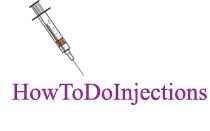- Joined
- Jul 25, 2008
- Messages
- 1,700
However pre-bed I usually have plenty of fats in my system. I often (when not dieting) have peanut butter or some combo of fats/protein. I always wait at least 30 minutes after eating my last snack before administering the CJC/GHRP and going to bed.
I always thought carbs were the only food that interacted with these peptides. Its very interesting that fats do as well. My new method is cjc/ghrp pwo, then 30min cardio then shake and pre bed is 50g whey/olive oil, then 30min later cjc/ghrp. So the peptides can react with carbs and fats, how about protien? Would it be ok to have some amino acids with the cjc/ghrp pwo or should even protien not be present at time of injection? Thanks
Carbs aren't nearly as inhibitory as fatty acids.
Peino, R., Cordido, F., Peñalva, A., Alvarez, C.V., Dieguez, C. and Casanueva, F.F. (1996) Acipimox-mediated plasma free fatty acid depression per se stimulates growth hormone (GH) secretion in normal subjects and potentiates the response to other GH-releasing stimuli. J. Clin. Endocrinol. Metab. 81, 909–913
ABSTRACT:
Increases in plasma free fatty acids (FFA) inhibit the GH response to a variety of stimuli; however, the role of FFA depression in GH control is far from understood. In the present work, FFA reduction was obtained by the administration to normal subjects of acipimox, a lipid-lowering drug devoid of side-effects. Each subject tested underwent two paired tests. In one, acipimox was administered orally at a dose of 250 mg at -270 min and at a dose of 250 mg at -60 min; in the matched test, placebo was given at similar intervals.
To induce GH release, four stimuli acting through different mechanisms were used: pyridostigmine (120 mg, orally) at -60 min, GHRH (1 ug/kg, iv) at 0 min, GH-releasing peptide (GHRP-6; His-D-Trp-Ala-Trp-D-Phe- Lys-NH,; 1 ug/kg, iv) at 0 min, and finally, GHRH plus GHRP-6 at the same doses at 0 min. GH secretion was analyzed as the area under the secretory curve (AUC; mean +/- SE, micrograms per L/120 min).
Acipimox pretreatment alone (n = 6) induced a reduction in FFA levels compared with placebo treatment. The FFA reduction led to a sustained GH secretion that increased from 2.4 +/- 1.8 ug/L at -120 min to 14.2 +/- 4.0 at 120 min. The GH AUC for placebo was 266 +/- 100, and that for acipimox was 1781 +/- 408 (P < 0.05). In the pyridostigmine- treated group (n = 61, the acipimox-pyridostigmine AUC (2046 +/- 323) was higher (P < 0.05) than the placebo-pyridostigmine AUC (764 +/- lOl), but was not different from the AUC of acipimox alone. Previous FFA reduction nearly doubled the GHRH-mediated GH secretion (n = 6; placebo-GHRH AUC, 1817 +/- 365; acipimox-GHRH test, 3228 +/- 876; P < 0.05). A similar enhancement was observed when the stimulus employed was GHRP-6 (n = 6; placebo-GHRP-6 AUC, 2034 +/- 295; acipimox-GHRP-6, 4827 +/- 703; P < 0.05). Furthermore, even the most potent GH stimulus known to date, i.e. GHRH plus GHRP-6, was enhanced by the FFA suppression (placebo- GHRH-GHRP-6 AUC, 2034 +/- 277; acipimox-GHRH-GHRP-6,5809 +/- 758; P < 0.05). The enhancing effect of lowering FFA levels was additive regardless of the stimulus employed.
These results indicate that 1) FFA reduction per se stimulates GH secretion with a delayed time of action; 2) FFA reduction enhanced in an additive manner the GH secretion elicited by such different stimuli as pyridostigmine, GHRH, and GHRP-6; and 3) the observation that FFA reduction enhanced the response to the most potent GH stimulus, GHRH plus GHRP-6, suggests that FFA suppression acts by a separate mechanism. FFA reduction may have value in the clinical setting for assessing GH reserve.
ABSTRACT:
Increases in plasma free fatty acids (FFA) inhibit the GH response to a variety of stimuli; however, the role of FFA depression in GH control is far from understood. In the present work, FFA reduction was obtained by the administration to normal subjects of acipimox, a lipid-lowering drug devoid of side-effects. Each subject tested underwent two paired tests. In one, acipimox was administered orally at a dose of 250 mg at -270 min and at a dose of 250 mg at -60 min; in the matched test, placebo was given at similar intervals.
To induce GH release, four stimuli acting through different mechanisms were used: pyridostigmine (120 mg, orally) at -60 min, GHRH (1 ug/kg, iv) at 0 min, GH-releasing peptide (GHRP-6; His-D-Trp-Ala-Trp-D-Phe- Lys-NH,; 1 ug/kg, iv) at 0 min, and finally, GHRH plus GHRP-6 at the same doses at 0 min. GH secretion was analyzed as the area under the secretory curve (AUC; mean +/- SE, micrograms per L/120 min).
Acipimox pretreatment alone (n = 6) induced a reduction in FFA levels compared with placebo treatment. The FFA reduction led to a sustained GH secretion that increased from 2.4 +/- 1.8 ug/L at -120 min to 14.2 +/- 4.0 at 120 min. The GH AUC for placebo was 266 +/- 100, and that for acipimox was 1781 +/- 408 (P < 0.05). In the pyridostigmine- treated group (n = 61, the acipimox-pyridostigmine AUC (2046 +/- 323) was higher (P < 0.05) than the placebo-pyridostigmine AUC (764 +/- lOl), but was not different from the AUC of acipimox alone. Previous FFA reduction nearly doubled the GHRH-mediated GH secretion (n = 6; placebo-GHRH AUC, 1817 +/- 365; acipimox-GHRH test, 3228 +/- 876; P < 0.05). A similar enhancement was observed when the stimulus employed was GHRP-6 (n = 6; placebo-GHRP-6 AUC, 2034 +/- 295; acipimox-GHRP-6, 4827 +/- 703; P < 0.05). Furthermore, even the most potent GH stimulus known to date, i.e. GHRH plus GHRP-6, was enhanced by the FFA suppression (placebo- GHRH-GHRP-6 AUC, 2034 +/- 277; acipimox-GHRH-GHRP-6,5809 +/- 758; P < 0.05). The enhancing effect of lowering FFA levels was additive regardless of the stimulus employed.
These results indicate that 1) FFA reduction per se stimulates GH secretion with a delayed time of action; 2) FFA reduction enhanced in an additive manner the GH secretion elicited by such different stimuli as pyridostigmine, GHRH, and GHRP-6; and 3) the observation that FFA reduction enhanced the response to the most potent GH stimulus, GHRH plus GHRP-6, suggests that FFA suppression acts by a separate mechanism. FFA reduction may have value in the clinical setting for assessing GH reserve.




















































































